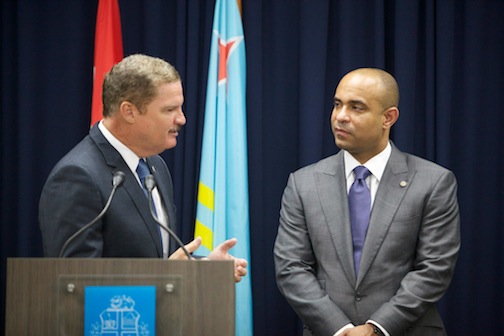Above: Aruba PM Mike Eman and Haiti PM Laurent Lamothe (Photo: OPM Haiti)
By Alexander Britell
In a region with few natural resources, tourism is to the Caribbean as oil is to the Middle East.
To be sure, some countries capitalize on their tourism product better than others — and are working to further diversify their economies — but as the largest contributor to gross domestic product in the region, harnessing tourism’s potential has become a natural choice for the majority of Caribbean governments.
Haiti’s government has been trying to develop a tourism sector in a country where it has traditionally contributed only a small fraction of the gross domestic product.
According to the most recent data from the United Nations Economic Commission for Latin America and the Caribbean (for Haiti, it was not available past 2006) tourism contributed to just 2.5 percent of Haiti’s GDP.
In the same year, the number was around 11 percent for its neighbour on Hispaniola, the Dominican Republic.
This week, Haiti Prime Minister Laurent Lamothe led a delegation to the Dutch Caribbean island of Aruba, in large part to learn from the ways that island is taking advantage of tourism.
Aruba, according to recent estimates, derives as much as 80 percent of its GDP from the tourism sector.
“The construction model they have — the infrastructure, the involvement of the private sector —here you have a lot of tourism infrastructure,” he told Caribbean Journal by phone from Aruba. “We’re trying to do the same in Haiti, so they definitely have the right model.”
While Haiti’s capital, Port-au-Prince, is seeing a wave of new hotel construction, led by the five-star Royal Oasis, which opened in December, areas north and south of the capital are the main focus for the government, in a bid to advantages of Haiti’s own brand of sun, sand and sea.
“That’s the model we want to use in Haiti — as we have the sun, we have the beaches and we have the white sand,” he said. “We want to do the same in terms of models, and we want also to understand the investors — what they’re seeking from the private sector.”
He said that as Haiti seeks to diversify its growth sectors, “tourism is a very important one.”
“Haiti has extraordinary beaches, sun year round to offer, we’re working on security — I think security is going much better than it was before, and we have good investment laws,” he said. “What we’re doing is the mobilization and the marketing of those for investment.”
The security sector will present a challenge, however. The US and Canadian governments issued renewed travel warnings to Haiti at the end of 2012, citing the country’s security situation.
In a pointed response, Haiti’s government has pointed to the fact that the country’s murder rates is in fact one of the lowest in the region, and far lower than those of countries with far stronger tourism sectors, like Jamaica.
Following the Aruba trip, Lamothe said he was “impressed” by the leadership of Aruba Prime Minister Mike Eman, with whom he met on Thursday.
“We were definitely impressed by the extraordinary work that’s being done on the tourism sector, in infrastructure development, and infrastructure financing,” Lamothe said. “The goal of the visit was to work on cooperation in infrastructure development, especially financing models, on education, on tourism.”
“We are striving to grow our tourism sector, so it was important for us to see the different tourism models in Aruba,” he said.
The trip was also part of a wider effort for Haiti to redefine its role within the Caribbean region, both with CARICOM countries and overseas territories like Aruba.
“Our policy is to get closer to CARICOM countries, and to Caribbean countries,” he said. “We’re trying to push for solidarity and integration and cooperation amongst Caribbean countries, and also to cooperate and share experiences of successful models — so this is what we’ve done.”
